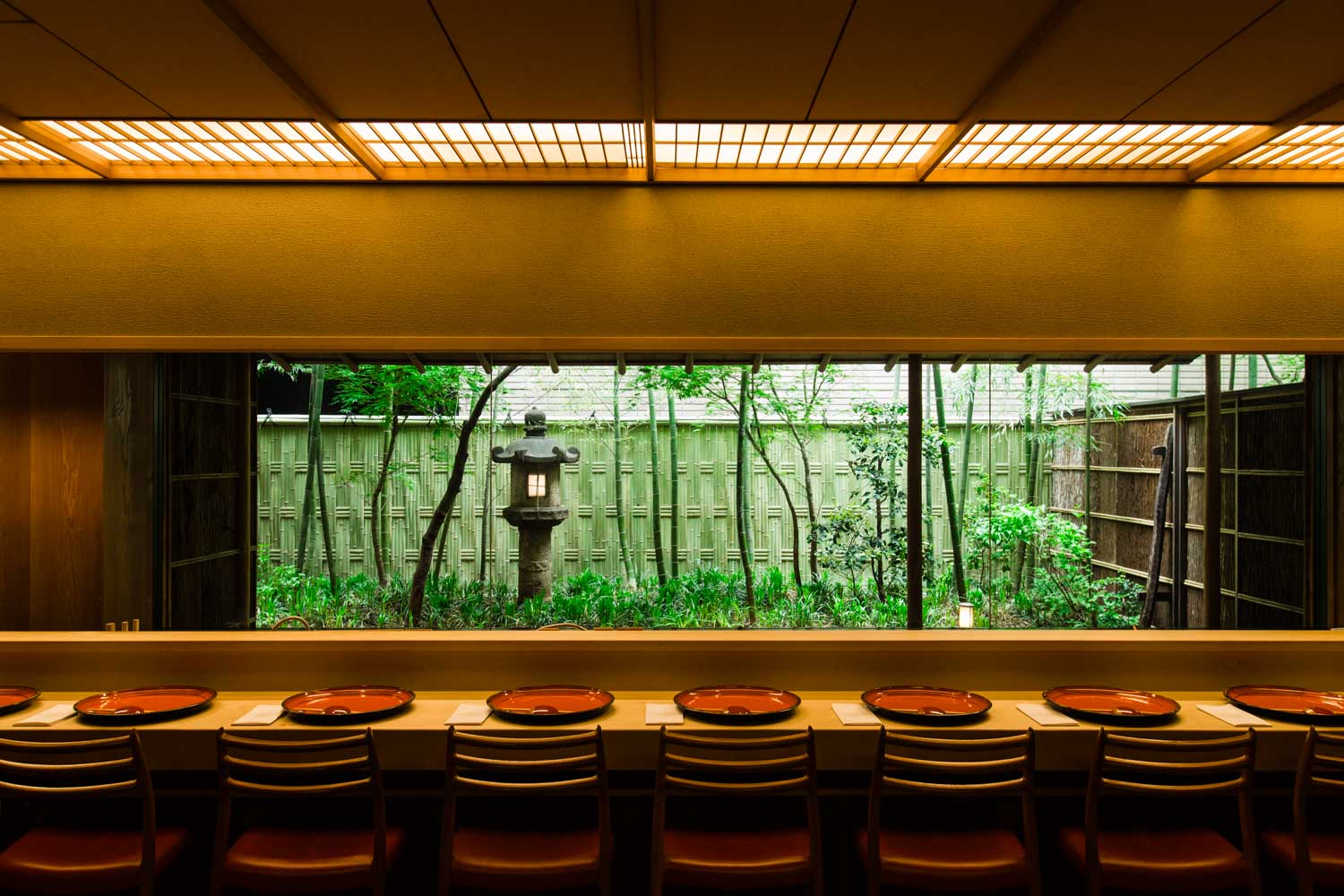
Tokyo
Akasaka Kikunoi
赤坂菊乃井
A faithful recreation of Kyoto in the heart of Tokyo, Akasaka Kikunoi is the perfect place to escape the noise and frenetic pace of the metropolis. It is a sanctuary offering sumptuous Kyoto flavors. And not to be missed is the chance to sit at the counter and watch the chefs at work, an opportunity not available at the Kikunoi main restaurant in Kyoto.
This is the long-awaited Tokyo restaurant of Kikunoi, one of the most famous restaurants of Japanese cuisine the world over, established in Kyoto in 1912 by the grandfather of Yoshihiro Murata, the present and third generation chef. Akasaka is dotted with towering office buildings as well as shopping and entertainment facilities, and yet in the midst of it all, a narrow stone path flanked by bamboo leads you to Akasaka Kikunoi. Stepping inside the spacious grounds, a beautiful building appears and in an instant, you are transported to Kyoto.
When asked about the motivation to open a restaurant in Kyoto, Chef Murata reminds us of his dedication to the work of sharing Japanese cuisine with the world. “When you think about the big cities in the world, Tokyo sits right alongside New York, Paris and London. When you visit Paris, for example, you can enjoy traditional French cuisine. In the same way, we have to offer traditional Japanese cuisine in Tokyo too. It has been my dream since my 20s to bring the flavors of authentic Japanese cuisine to the people of the world.”
The Akasaka restaurant has two faces – a formal traditional restaurant known as ryotei, and counter seating overlooking the kitchen known as kappo. In addition, the counter seating on the first floor takes two different forms. The first is a long and spacious 13-seat counter looking out to a charming garden of bamboo and lanterns outside, and the second is a slightly elevated six-seat counter. From both you are treated to a view of the chefs busily working in the kitchen to prepare your meal, whetting your appetite for the course to come. This is the real pleasure of sitting at the counter and the distinguishing feature of the Akasaka restaurant. Moving to the second floor, you can find a tea room and tatami mat rooms designed in the traditional sukiya style from Kyoto incorporating authentic tea house aesthetics. And as with the main restaurant in Kyoto, your eyes are delighted at every turn by the hanging scrolls, flowers, and furnishings, which all speak of the present season.
CUISINE
A faithful recreation of Kyoto in the heart of Tokyo
Chef Murata says the three keys to Japanese cuisine and perfume, texture and the element of surprise. Each is essential and without the surprise component, the diner’s response to a meal is at best indifferent and at worst, boredom. The surprise can come through flavor, appearance or the story behind a dish – no matter what, it must be there. He firmly believes that people seek fine dining for entertainment, just like a concert, play or opera.
Kikunoi’s cuisine aspires for an aesthetic ideal found in tea ceremony called kireisabi, which can be translated as ‘rustic elegance’. It demonstrates refined beauty with no showy or flashy elements, and it is subdued but still shows vigor – not overly delicate or frail. The cuisine manages to stay ahead of trends whilst also maintaining traditions.
Typically, there are significant variations in the cuisine of west and east Japan, or the regions of Kansai and Kanto, respectively. However, at Kikunoi not a single thing is changed. Right here in Tokyo, you can enjoy the true flavors and experience the true charm of Kikunoi Kyoto. The menu changes to reflect the season between the 20th and 25th of each month and the following is just a taste of the incredible dishes that may be found in the early spring Yayoi degustation menu, following the pattern of a traditional Kaiseki meal.
Chef Murata’s prized Akashi sea bream is served sashimi style, to highlight its delicious innate flavors, alongside plump kuruma ebi shrimp. Next, a platter called kuchidori arrives with an assortment of dishes so elaborate in of themselves and for the incredible morsels they hold within that you won’t know where to start. The selection of seasonal treats takes you on a journey around Kyoto specialties with mountain yam, shrimp and omelet sushi, firefly squid in an egg yolk vinaigrette, blanched wasabi greens, dressed fava beans, and a rare dish of minced vegetables and seafood in vinegared miso called teppai.
Another course known as futamono refers to the lidded dish that sweeps you away on its incredible aromas as you remove the lid to reveal the goodness within. A clam dumpling to celebrate the Doll’s Festival on March 3rd is adorned in the verdant colors of sansai mountain vegetables, bamboo shoots, carrot, young sansho leaves, water dropwort. While the ingredients and seasonal motifs change with each season, you will no doubt be captivated by both the presentation and delicious flavors of Kikunoi.
INGREDIENTS
Presentation of the authentic Kikunoi experience is possible through the delivery twice of week of precious cargo from Kikunoi in Kyoto. A special space in just one corner of Kikunoi’s vast grounds is where all the ingredients are managed, and boxes of Kyoto vegetables and Akashi sea bream are packaged up so guests in Tokyo may enjoy the same flavors achieved in Kyoto.
One of the keys to Kikunoi’s ability to create superb seasonal food is the fact that the chefs visit the source of their ingredients. It is not uncommon to find them helping in the fields of farmers growing their beloved Kyoto vegetables. One story goes that no matter how long they waited, a chef who had gone to collect produce just didn’t come back, only to be found completely absorbed in field work. These face-to-face interactions ensure a better understanding of the ingredients and procurement of items of a quality far superior to what can be found in the markets.
Approximately 30 years ago, a group of chefs concerned about the diminishing resources of Kyoto vegetables set about revitalizing production of the richly colored and flavored vegetables Kyoto had once been famous for. They visited farmers who had preserved seeds of traditional vegetables and were growing them just for personal consumption, begging them to start growing more with a guarantee that they would buy whatever was produced irrespective of its shape and appearance. Word spread, and production has increased to levels meaning that these unique vegetables can be found in marketplaces once again.
Premium seafood, including the plump and succulent sea bream found in the course, comes from a fishmonger in Akashi on the Seto Inland Sea whose relationship with Kikunoi goes back decades. Chef Murata even boarded the boats in his younger days, learning the keys to selecting the best seafood and the best way to showcase each variety’s flavors, be it with some interventions such as grilling, or the simple direct style of sashimi. Many Kikunoi guests time their visits with their favorite seasonal items, a particular favorite being ayu sweetfish. An ingredient intrinsically linked with early summer, Kikunoi’s ayu all come from a trusted supplier on Lake Biwa in neighboring Shiga Prefecture.


CHEF
Yoshihiro Murata
Course
- The price includes our booking fee of ¥8,000
- The price includes our booking fee of ¥8,000
- The price includes our booking fee of ¥8,000
- The price includes our booking fee of ¥8,000
- The price includes our booking fee of ¥8,000
- The price includes our booking fee of ¥8,000
- The price includes our booking fee of ¥8,000
- The price includes our booking fee of ¥8,000
- The price includes our booking fee of ¥8,000
- The price includes our booking fee of ¥8,000
- The price includes our booking fee of ¥8,000
- The price includes our booking fee of ¥8,000
- The price includes our booking fee of ¥8,000
- The price includes our booking fee of ¥8,000






